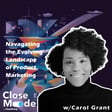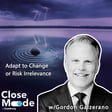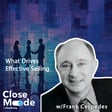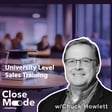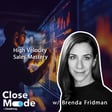Become a Creator today!Start creating today - Share your story with the world!
Start for free
00:00:00
00:00:01

REPORT: Key Findings That Separate Top Sales Teams From the Rest
In this episode, Dan Sanchez chats with Brian Dietmeyer, the host of CloseMode, about the SAMA Research Report. They delve into the changing landscape of the marketplace, with a focus on high-performing strategies for enterprise sales leaders. Discover key insights on investments, coaching, and deal quality that can help sales professionals excel in today's competitive sales environment.
Timestamps:
00:00 Report offers sneak peek at high/low performers.
04:18 Data bias, importance of high-quality coaching. Preventive vs. firefighting.
07:05 Challenging the audience on coaching and win rates.
10:00 High performers have formal close plans for deals.
Transcript
Introduction to Research with SAMMA
00:00:03
Speaker
Welcome back to Close Mode, the enterprise sale show. I'm Dan Sanchez and I'm here with Brian Deepmeyer. The producer is the host again and shifting the host into the guest seat. Brian, thank you for joining me.
Purpose of the Research: 2024 Sales Strategies
00:00:15
Speaker
I know you just did some research, some original research with SAMMA and I wanted to have a whole episode about this because I know you guys learned some awesome stuff from this research that you did with SAMMA and I'd love to kick it off with like, wait, why did you even have to start a research report? What got you going down this path?
00:00:33
Speaker
And I would, I would say, don't, don't hang up your phone or however you're listening to this now, because I'm not going to, I'm not going to kill you with a 40 graphs and charts. I'm just going to get after why we did it. Yeah. Well, and the highlights are what the heck should we be doing in 2024 based on what we went after? So why did we do it?
Shifts in the Marketplace: New Focus on Funnel Opportunities
00:00:52
Speaker
You and I have spoken about this when.
00:00:54
Speaker
I had the honor of being your guest in the previous couple sections that the marketplace has changed. It's really fast. It sucks compared to what's in the past. We're now dealing with 2X funnel versus success funnel. We have to close more of what's in our funnel versus going after more and more new logos all the time. Renewals are tougher. We need to focus more on those.
00:01:14
Speaker
Um, win rates are bad and, and a lot of the old solutions aren't working. So we wanted to get after, but we did have some data secondary research that suggests when people are really good in late stage, that their win rates and their deal optimization
Performance Analysis: Investment Impact on Sales Teams
00:01:29
Speaker
were smoking. But what we didn't know is why. So, okay. Yeah. So yeah, if you're good at this, that's helpful, but what makes you good at it? And so we wanted to get after kind of what, what investments people were making.
00:01:42
Speaker
So you're leaving me in suspense here. Like, well, why was it? What did you learn? Well, so we, we looked at. First of all, after the research was done, and by the way, we haven't even published the report yet. So I'm, I'm giving you like what's on a scribble sheet on my desk. What we wanted to know, first of all, we just, we lumped everybody into high performers and low performers. High performers were people who had a greater than 60% win rate. Remember the market average right now is about 47. So.
00:02:09
Speaker
greater than 60% win rate and they all made their team goal. The low performers were under 40% in win rate and missed their goal. So the question was, how do you guys view the world? Some of it was like, how do you feel about this investment versus that? And we correlated it back to their actual numbers to see if there was disconnect. A lot of people liked investments that really weren't doing squat for them. So, but that, yeah, at the highest level.
00:02:33
Speaker
So here's, here's
High Performers vs Low Performers: The Role of Coaching
00:02:35
Speaker
what we found. If I, if I try to keep this simple there, we looked at investments. Let's say we looked at training, we looked at coaching, we looked at technology and we even got tech and we got underneath, you know, CRM, CPQ systems, uh, value management tools, you know, in-call recording tools. And so a technology we got even down lower. And then we looked at things like sales playbooks and marketing. Like so of all these investments.
00:03:02
Speaker
What are you making top performers and low performers? And, and what's even more interesting to me, I shouldn't say more interesting, but kind of blew me away. Is we ask them about, okay, so if you've made these investments, what, what's your rigor? If you buy a sales training event, what's your rigor and implementing and adopting and measuring that thing? If you buy a sales tool, what's your rigor? And here I'll start giving you someone like the eye and the curtain. No shock. The top performers had rigor. If they wrote a check.
00:03:30
Speaker
For something, people needed to use it and it was inspected and that kind of thing. The low performers are writing checks and rolling out sales training and rolling out sales tools and just hoping people will use them. And I know that goes against the grain. A lot of people culturally struggle with, I'm going to make people use them, but let me tell you something. If the top performers, they, I think they made a decision on, on the right checks to write.
00:03:51
Speaker
And then they implemented in the top performers, you know, as it relates to tech, they were using more, more value management and mall quote, more call recording tools. The low performers weren't even looking, they were relying on, on, uh, pricing systems and CRM as their technology where the, the, the, yeah, the, the leaders were focusing more, but the number one driver.
00:04:13
Speaker
And, and I'm in the coaching business. So someone might say, Oh, you fake news. You buy us the data. Uh, we did, we did this research in conjunction with strategic account management association and they kept us honest. They won't allow this to happen. And, and the number one driver from people who are making the numbers, the number one investment was, was coaching. And, and not only that high quality coaching, we further asked both groups.
00:04:38
Speaker
Is your coaching more inspecting and auditing? Is your coaching more value added where you're actually helping the rep get a deal closed? So the, yeah, the folks that are, that are beating their number and have a greater win rate have a much higher degree, like a two acts of coaching. And not only that, they believe in it more, um, than, than the low performers do. And they're putting more rigor into, and cadence into the system
Proactive vs Reactive Sales Strategies
00:05:00
Speaker
of making it happen. They also believed, uh, and getting to deals earlier, the low performers were more focused on.
00:05:07
Speaker
How do I get upstream earlier? I need to start working my deals earlier. We found this theme of fire prevention versus firefighting. The top performers were doing ton more fire prevention. They're making investments. They're doing work earlier. The low performers were firefighting and wanting to get back upstream. And when we asked about where do you want to go next?
00:05:29
Speaker
The top performers said deal quality. The low performers said win rate. And, and as you know, one of my partners, Patrick said to me, he's like, that that's kind of like the Maslow's thing. Like the, the low performers just want food and the high performers, they already got food. They want quality food now. Yeah.
Importance of Early High-Quality Coaching in Sales
00:05:49
Speaker
Man, that makes a lot of sense. So how does this actually impact our listeners? What can enterprise sales leaders actually do with this information?
00:05:59
Speaker
Well, it's, it's, it, it, it goes back to what, what we saw. Well, a couple of things. If you're going to make an investment in something and we're worried about 2024 or focused on 2024, you know, that's what can we still yet do this year as of like June ish of 2024. We got a couple of quarters left. And if you're going to make an investment in something, if it's training, even though quite frankly, training.
00:06:27
Speaker
Product marketing and playbooks came up very low in terms of impact, in terms of actual impact on one rate and deal quality. But if you're going to do them, top performers invest at the time, twice the time, twice the money and twice the rigor. So if you're going to make the investment that in this economy, yeah, all in, all in. Cause when, yeah, in a rising tide, you can make the investment and walk away. But now if you're going to spend scarce dollars,
00:06:55
Speaker
make, make sure it happens, but yeah, the, the number one issue that came out of the research was high quality coaching early, early in the sales stage. So that's, that's what we, yeah, that that's what we could
Company Success Case Study: Best Practices or Superior Product?
00:07:07
Speaker
be looking at. You know, that it's funny because in the, in the session we just ran, um, I don't know if I can say the company name, but a gentleman stood up and said, cause I said a 5% of pipe is being coached, you know, and win rates are 47%.
00:07:21
Speaker
And he said in my company, everybody's involved a hundred percent of deals and 90% win rate. Now, is that true? It might be. He had two or three of his peers in the room. And I said, my first question to him in front of the whole group was why the hell are you in my session? You know, why are you sitting in the back? Why aren't you up here? Cause that's, that's kind of the point. Now I think that's an extreme. I don't think anyone's going to want to coach a hundred percent of their pipe. And I don't think very few people are going to get to 90% close rate unless you're super hyper crazy about what goes into your funnel.
00:07:51
Speaker
So how big of a company was it? Big, massively, massively traded and industrial. It's like small players. I'm like, yeah, but you only have 10 reps. So this was in several of us after we're sitting around going, how it's like an industrial products, an industrial products company. And we're like, how the hell that maybe, you know, you got a question. Do they just have a better mouse trap? You know, are they that good? Are they as their chemistry that much different than the chemistry of their competitors? Because
00:08:20
Speaker
boom, they're, they're exploding. But that your question was, you know, what can we do in 2024?
Enhancing Team Success: Focus on Middle Performers
00:08:25
Speaker
Look, if, if, if you were, when I quote that 47% close rate, that's 47% closed on average below the flip of a coin, by the way, the probabilities below the flip of a coin of deals that are forecast to close at 90%.
00:08:39
Speaker
So there's a, there's a problem. We need to touch those deals, somebody in the right way, right. And managers say, I don't have time or I don't have the skills. Cause I was promoted from being a great rep, whatever it is, we've got to, that's what we can do in 2024 is get to the deals that are in our funnel. Get to the middle players of our team. The rock stars are going to make their number, get to the middle players of our team and the deals in the middle of our funnel. And, and we need.
00:09:05
Speaker
We need high quality touches with those deals to get a move through the sales cycle. We need to close a much higher percent than 47% with a pipe that
00:09:15
Speaker
on average this year is two X versus four to six X a few years ago. So that's the most critical thing people predicted close at 90 or 90% prediction or no, it's those forecasted to close at 90% at 90 and they're getting 47. So flip a coin, flip a coin instead of going through all that forecasting stuff, just flip, flip a coin. It's you're going to get better odds.
00:09:37
Speaker
Yeah. Goodness. So the big thing I'm taking away, and I think this is kind of like a, this is like larger than life kind of skill is like go all in. Cause if you only go havesies, it never works out. We kind of see that across the board. I mean, any, any industry would even want to like the health and wellness, I bet you all the health coaches out there are like, yeah, the people that do the best are the ones that go all in. Well, speaking of going all in, I will add,
00:10:04
Speaker
What one more data point, which is we asked about a formal closed plan. Do you have a formal closed plan? And we defined that as a rigorous stated process for at a certain point. We say it's at a certain point in the funnel. What are the steps that we take?
00:10:20
Speaker
You know, and the rigor we put in to make sure the steel is getting closed. The top performers had formal closed plans at like six acts of the low performers, the low performers, again, it's firefighting, fire prevention. So maybe that that's the biggest takeaway is the top performers were all about fire prevention. They were doing stuff earlier. They had more, they had more cadence, they had more rigor and the low performers were firefighting and wanting food versus quality food.
00:10:45
Speaker
There we go. So Brian, thank you for sharing some of the insights from this report. I'm looking forward to actually looking at the full report.
Conclusion and Further Reading
00:10:53
Speaker
I will link to it in the show notes when it becomes available. If you don't see it in the show notes, cause it's not available yet, but because we're recording this a few weeks ahead of when we release it, chances are that link will be in the show notes. But if it's not, wait, it's, it's coming. Get on the newsletter, go to closemode.media and you'll see a form right on the homepage where you can sign up, get on the newsletter. We'll certainly be pushing it out there.
00:11:40
Speaker
Great. Yep.
